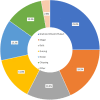Dalit's livelihoods in Nepal: income sources and determinants
- PMID: 35909425
- PMCID: PMC9325665
- DOI: 10.1007/s10668-022-02582-2
Dalit's livelihoods in Nepal: income sources and determinants
Abstract
This paper focuses on the lack of income opportunities for Dalits in Nepal, as they are the most affected group in any disaster. The presence of vulnerable family members in Dalit households may further increase their income deprivation. We therefore studied Dalit households' income sources and identified income determinants in Gandaki Rural Municipality in Gorkha District-the epicentre of the 2015 earthquake. We observed a higher dependency of Dalit households on daily wages, livestock sales, social security allowances, and vegetables sales; however, remittance and seasonal job earnings represented the largest share of household incomes. We observed a significant difference in per capita income between farm (US$46) and non-farm (US$273) income sources, with the difference smallest in the lowest income quantile and the largest in the highest quantile. When the household head was a single woman, we observed a reduction in non-farm (by 29%) and total incomes (by 23%). Likewise, when the household head had a chronic health problem, or the household included an elderly family member, there was a reduction in the household's income. We suggest economic interventions for Dalit households to prevent increased social exclusion in the development process, specifically focusing on vulnerable individuals and households in the lowest income quantile.
Keywords: Dalit; Gorkha earthquake; Income; Nepal; Purnima.
© The Author(s), under exclusive licence to Springer Nature B.V. 2022, Springer Nature or its licensor holds exclusive rights to this article under a publishing agreement with the author(s) or other rightsholder(s); author self-archiving of the accepted manuscript version of this article is solely governed by the terms of such publishing agreement and applicable law.
Conflict of interest statement
Conflict of interestAuthors declare no conflict of interests.
Figures
Similar articles
-
Livestock and livelihoods of smallholder cattle-owning households in Cambodia: the contribution of on-farm and off-farm activities to income and food security.Trop Anim Health Prod. 2018 Dec;50(8):1747-1761. doi: 10.1007/s11250-018-1615-6. Epub 2018 May 23. Trop Anim Health Prod. 2018. PMID: 29796792
-
The economic burden of HIV/AIDS on individuals and households in Nepal: a quantitative study.BMC Health Serv Res. 2017 Jan 24;17(1):76. doi: 10.1186/s12913-017-1976-y. BMC Health Serv Res. 2017. PMID: 28118830 Free PMC article.
-
The importance of bushmeat in the livelihoods of West African cash-crop farmers living in a faunally-depleted landscape.PLoS One. 2013 Aug 16;8(8):e72807. doi: 10.1371/journal.pone.0072807. eCollection 2013. PLoS One. 2013. PMID: 23977355 Free PMC article.
-
The impact of the 2008 financial crisis on food security and food expenditures in Mexico: a disproportionate effect on the vulnerable.Public Health Nutr. 2015 Nov;18(16):2934-42. doi: 10.1017/S1368980014002493. Epub 2014 Nov 27. Public Health Nutr. 2015. PMID: 25428800 Free PMC article.
-
Does social capital improve farm productivity and food security? Evidence from cocoa-based farming households in Southwestern Nigeria.Heliyon. 2021 Mar 29;7(3):e06592. doi: 10.1016/j.heliyon.2021.e06592. eCollection 2021 Mar. Heliyon. 2021. PMID: 33869842 Free PMC article. Review.
Cited by
-
Family Support Paradox: Exploring Family Support and Life Satisfaction Among Older Adults in Rural Eastern Nepal.Behav Sci (Basel). 2025 Mar 24;15(4):411. doi: 10.3390/bs15040411. Behav Sci (Basel). 2025. PMID: 40282033 Free PMC article.
-
Determinants of loss to follow-up among people living with HIV receiving antiretroviral therapy in a universal test and treat setting: A retrospective cohort study in Nepal.Public Health Pract (Oxf). 2025 Jun 26;10:100634. doi: 10.1016/j.puhip.2025.100634. eCollection 2025 Dec. Public Health Pract (Oxf). 2025. PMID: 40688743 Free PMC article.
-
Catastrophic and impoverishing impacts of health expenditures: a focus on non-communicable diseases in Pokhara Metropolitan City, Nepal.BMC Public Health. 2025 Apr 4;25(1):1283. doi: 10.1186/s12889-025-22418-8. BMC Public Health. 2025. PMID: 40186202 Free PMC article.
References
-
- ACAPS. (2015). Lessons learned for Nepal earthquake response. https://www.alnap.org/system/files/content/resource/files/main/l-acaps-l.... Accessed 7 August, 2019
-
- Adhikari J, Bruslé T, Subedi M, Rai M, Baral C. COVID-19’s impact on Nepalese migrants: families. Vulnerability, coping strategies, and the role of state and non-state actors. Critical Asian Studies. 2022 doi: 10.1080/14672715.2022.2076707. - DOI
-
- Bankoff G, Frerks G, Hilhorst D. Mapping vulnerability: Disasters, development and people. In: Bankoff G, Frerks G, Hilhorst D, editors. Mapping vulnerability: Disasters, development and people. Earthscan; 2013. pp. 1–236.
LinkOut - more resources
Full Text Sources




